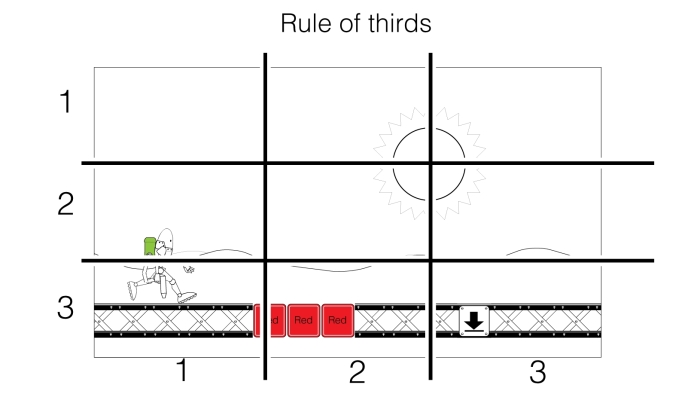Platformers have a more complex and fanciful structure of elements on the screen. In contrast to puzzle games, the game screen is not just a regular grid of items, but a composition that is close to landscape painting or photography: some characters, foreground and background, horizon, sky with objects like clouds, and the Sun. Thus, some traditional visual art rules can be used to create an expressive image. First, the horizontal direction of movement should be chosen. Traditionally, protagonists in platform games run from left to right. This is correlated with many familiar processes such as the direction of reading (in western cultures), the direction arrows rotating in analog clocks, and so on. Therefore, the direction from left to right as a rule means forward, but from right to left means backward (just recall the images of history buttons in your Internet browser). In many platform games, the main character can move both forward and backward, but direction to the right is always dominated and related with progress in the game.
The vertical movement is usually directed from bottom to top. This is not a strict rule, but in many cases, players find such direction more comfortable and apprehensible. Apparently, this is because of some cultural models where it is much more delightful to climb into sky and clouds, rather than descending into the deep. Here you can see a schematic presentation of a composition rule known as the rule of thirds:

To construct a good visual composition of a scene, the rule of thirds can be used. It is common in photography and cinematography (for inspiration, look at any frame of a widescreen movie) and works very well for rectangular aspect ratios that mobile devices have. To apply it to the scene, the screen should be divided into three equal parts horizontally and three equal parts vertically. A simple grid should be developed. Then, the basic elements of the scene must be aligned to it. The protagonist has to be placed in the first third, the horizon line should be near one of the second horizontal lines of the grid, and so on. Remember that the rule of thirds is an artistic rule, not a mathematical one; it has some liberty in interpretation. Such a screen setup also complies with another visual rule known as the lead room . It says that a motion is perceived better if there is some space in front of a moving object; in the case of a game, it is the space in front of the running main character. Otherwise, the audience may think that an character is moving toward a wall and soon would be stopped or crushed.
Note
To increase the sense of speed, some tricks can be done with props. The geometry of items can be curved in a direction that is opposite to the vector of the protagonist's movement (in other words, it should be rotated a little counter clockwise). In an ideal case, some shear effects can be programmed to distort some screen layers
It is worth mentioning that if the protagonist changes the direction of movement, for instance, by moving backward, the screen layout should be recalculated on a fly. The virtual camera should shift smoothly so that the protagonist is placed in the third thirds of the screen.
